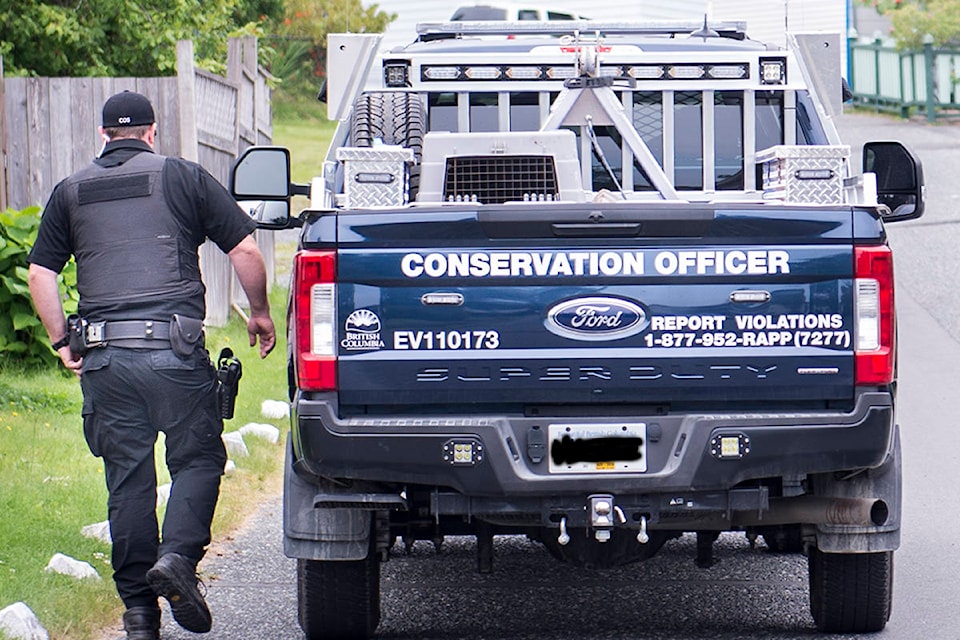We live in a region with a higher concentration of predator animals than anywhere else in Canada. That, according to BC Conservation Officer (CO) Brad Adams, helps explain why the North Island experiences more encounters with bears than most other regions.
Based in Port McNeill, Adams is one of 120 Conservation Officers in BC who, in an average year, responds to a province-wide total of nearly 30,000 wildlife conflict calls.
In the first five months of this year there have already been 19,000 calls, of which four (two black bear and two cougar) incidents on the Island have involved attacks.
But there is more to the bear story than animal population densities, and to find out what is behind the statistics, I rode along with Adams as he conducted a pro-active, Bear Aware patrol in the Tri-Port area.
“Bears are incredibly smart,” explained Adams, “and once they find an easy food source, they will continue to return to that site until there is nothing left to eat.” In the wild that food source is focused primarily on berries, but as Adams pointed out, “Bears don’t know the difference between wild and domestically grown food.”
He went on to describe how this year’s lack of a large wild berry crop is driving bears into town. “Unlike forests, urban gardens are watered and tended to daily. Droughts don’t impact growth in a garden the way they do in the wild and bears see gardens as a more reliable source of food.”
Driving through the first neighbourhood identified as having recent bear activity, it was only a matter of minutes before a local resident flagged him down.
According to the resident, earlier in the morning there’d been a large black bear in a fruit tree across the street.
What began as a simple and normal complaint got complicated though when Adams followed up with the neighbour across the street.
The resident was an elderly lady, and as Adams explained to me later, “To expect her to climb this tree, cut branches and pick the fruit is unrealistic.”
To complicate the matter even more, the tree is likely on the common property of the complex, and is therefore the responsibility of management or the owner of the complex and not the resident. What began as a five to ten minute call would now involve hours of follow-up, including enforcement and monitoring with multiple individuals spread out over several days.
Back in the truck and once again on patrol, it was only a few moments before Adams spotted another problem involving a backyard fruit tree.
Watching the CO approach the house, one couldn’t help but notice the tense body language of the owners, and I wondered if this would go as smoothly and cooperatively as the previous call.
Within a few minutes though, the situation had gone from somewhat tense to relaxed and conversational.
In the end, the owners had agreed to bring in some friends to help pick all the fruit that afternoon.
No infraction tickets or warnings were issued and all the CO had left to do was to follow up with a compliance drive-by the next day.
When asked how he manages this type of situation, Adams explained how he always prefers to, “begin low key and build a bit of rapport and understanding.”
As the patrol continued, a pattern began to develop with each stop.
When Adams would respond to a call, neighbours would often come over to his truck to talk about recent wildlife encounters.
At one stop, a total of seven neighbours (unrelated to the original call) came by to chat with him.
Adams explained this was quite normal, adding, “These people have concerns that need to be voiced and sometimes they feel more comfortable having that conversation face to face instead of over the phone. And that’s one of the reasons why these community patrols are so important.”
Throughout the day, Adams demonstrated an ability to adapt his response to the person and situation.
He has the legal authority to compel a homeowner to remove animal attractants from the yard, clean up garbage and/or issue an infraction ticket for $575.
However, despite the enforcement tools at his disposal, his first choice was to begin with a conversation.
He sees his work as, “ being proactive and out in the public instead of reactive.”
According to Adams, “one neighbour on a street can be the reason the bear is accessing the entire street.”
If he can locate that individual and convince them through education or enforcement to change their habits, the street returns to being a safer place and according to Adams, “the bear’s life is likely saved.”
- Bill McQuarrie article
